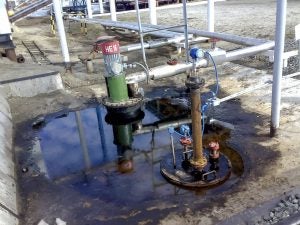 Last week, the Environmental Protection Agency released details of a new plan that aims to address concerns about future water shortages. The Water Reuse Action Plan suggests that by recycling and reusing more wastewater, we can “improve the availability of freshwater” and avoid a water access crisis.
Last week, the Environmental Protection Agency released details of a new plan that aims to address concerns about future water shortages. The Water Reuse Action Plan suggests that by recycling and reusing more wastewater, we can “improve the availability of freshwater” and avoid a water access crisis.
There are certainly a number of opportunities we can and should seize to make better use of our water resources, but the plan leaves out a lot of crucially important details that must be a part of any truly sustainable water plan.
One of the biggest concerns EDF has is how the plan frames (or, more specifically doesn’t frame) important issues with reusing the oil and gas industry’s wastewater.
Oil and gas wastewater is extremely complicated. It’s very salty and it can contain radioactive chemicals from deep underground, toxic substances used in the drilling process, and a slew of other concerning pollutants. What’s in the water varies from day-to-day, well site-to-well site and state-to-state, which makes it even more difficult to set any kind of safety standard for how to treat it.
To reduce the amount of freshwater needed to hydraulically fracture a new well, some companies have taken to reusing their own wastewater. That’s a good thing. But EPA’s plan suggests we should expand reuse — that it can be a near-term reality to treat wastewater and use it for irrigation, aquifer recharge and other purposes beyond the oilfield. And that is extremely problematic.
There are known unknowns
Based on what we know about the chemicals used by oil and gas companies, the natural ones that already exist underground, and how those two can interact — there are upwards of 2,000 different substances that could exist in any random sampling of oilfield wastewater. And we have very little understanding of the toxicity of these chemicals or how to monitor for them in the environment.
Unfortunately, EPA’s plan downplays that stark reality, describing concerns about unknowns as a “spectrum of perspectives” on the issue rather than fact, and including only one emerging state study as a sole action to address knowledge gaps.
If we’re not careful, EPA’s new water reuse plan could lead to more pollution Share on XDownplaying these very real challenges is extremely dangerous because if EPA ignores them and instead signals to cities, farmers, communities and others that it’s time to consider reusing a waste stream we don’t fully understand — that could create a heck of a lot more problems than it solves.
Others have been studying the potential to reuse other wastewater, like municipal effluent, for decades and are still working to identify and manage risks. In contrast, the research on oilfield wastewater is much less evolved. EPA must acknowledge that our study of oil and gas wastewater, in this context, lags behind these other reuse scenarios. We need to recognize the huge data gaps that need to be filled before we encourage expanding reuse of this waste stream.
What’s next?
The timing for all of this report matters. In the coming weeks, EPA is also expected to release a study about the management of the oil and gas industry’s wastewater in the context of the Clean Water Act. Specifically, the agency will address whether there is support to change federal rules to allow for broader discharge of treated wastewater into rivers, streams and other waterways.
Stakeholder input in EPA’s original draft was mixed. Many emphasized concerns about science and regulatory gaps. It will be important to watch what EPA says and does with the release of its final assessment.
If not managed properly, these two actions could send a risky signal that we’re ready now to bring more oilfield wastewater to more places and treat it for more uses, and that couldn’t be further from the truth. Until we know more, it would be a mistake to look to oilfield wastewater as a reliable solution to water scarcity.









